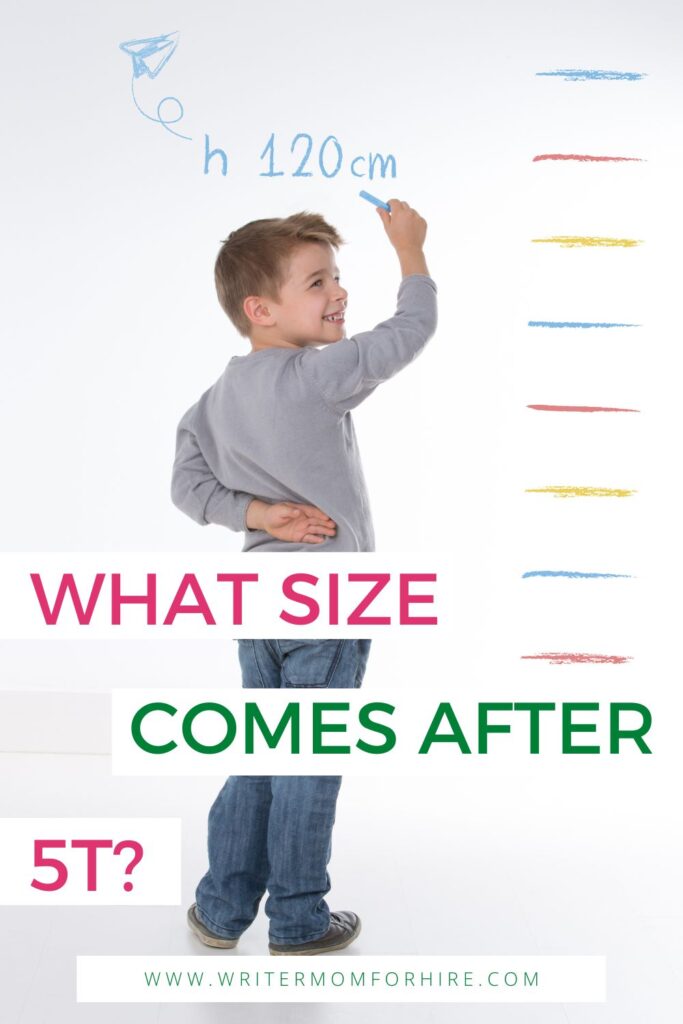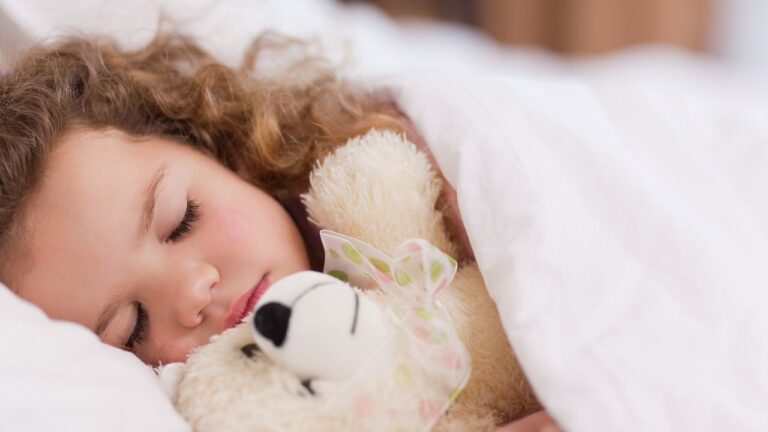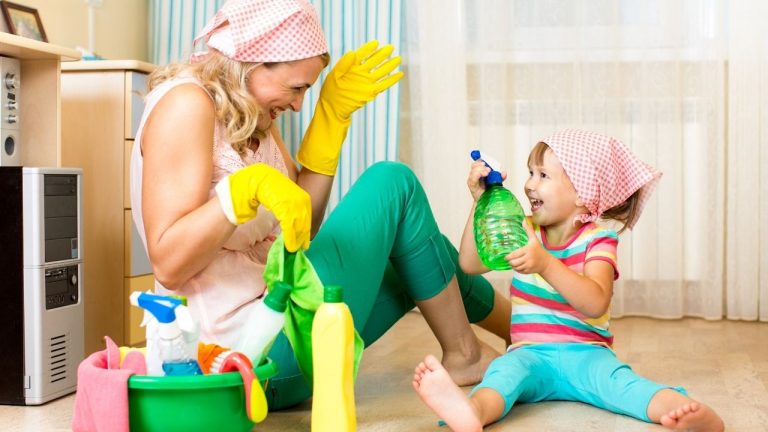What Size is After 5T? A Guide to Transitioning Past “Toddler” Sizes
This post may contain affiliate links and we may earn commissions when you make a purchase through these links (at no extra cost to you). See our disclosure policy for more details.
Everything You Need to Know About Moving Up a Size
Wondering what size comes after 5T? You’re not alone! Clothing sizes for kids and toddlers can be incredibly confusing.
I promise, I get it. I’ve often wondered what clothing or shoe size comes next as my kids hit a growth spurt.
(Well, my eldest, at least. By the time my second reaches the next size, I’ve got it covered.)
But worry not…
If your kiddo is outgrowing their 5T clothes, join me as we take a deep dive into the size that comes after 5T, taking your child’s measurements, knowing when to move to a bigger size, and much (much) more.
Ready? Let’s go.

What Size is After 5T?
Size 6 is after 5T. With most brands, this is generally the end of toddler sizes, or sizes ending in “T”.
However, because size 6 is quite a bit larger than 5T, some parents go to a regular size 5 first if the child is potty trained. While size 5 is considered bigger than 5T, 5T bottoms are often wider around the bottom to accommodate diapers and pull-ups.
Also, depending on your child’s size and how quickly they grow, you might not get much wear out of a size 5, which is why most parents go straight to a size 6.
The main difference between “toddler” and “regular” sizes? Toddler clothing sizes are based on the age when they are expected to fit into that size — regular clothing sizes are based on measurements.
Ready to TRANSFORM YOUR MORNINGS?
Do your mornings feel rushed? Are you craving a little more structure in your days, or even a sense of purpose?
Sign up for the FREE 7-Day Morning Makeover Challenge and start making meaningful changes to your morning routine right away.
Over the next seven days, you’ll:
- Define your perfect morning routine
- Find time in your busy morning
- Come up with a solid game plan and more!
Shirts
Size 6 shirts are often significantly larger than 5T shirts, but I’ve found that, for kids, wearing slightly baggy tops hasn’t been an issue. If the sleeves are a little long, you can always roll them up a little.
Pants
Because size 5 pants usually aren’t any longer than 5T pants, you’ll want to go directly to a size 6. If they’re a little long, you can always roll them up at the ends as needed.
I wouldn’t bother with a regular size 5 since they’re often more snug around the bottom.
Underwear
Buying underwear can be a little tricky, since the sizes don’t necessarily line up with that of regular clothing. To determine the right underwear size, you’ll need to know your child’s waist measurement.
(Don’t worry, we’ll cover some tips for taking these measurements shortly!)
Here’s a handy little chart to help you out.
Underwear Sizing for Girls
Underwear Sizing for Boys
Pajamas
Kids’ pajamas are typically designed to fit a little on the snug side, but if your child is moving into size 6 clothing, then size 6 pajamas will likely be a good fit.
Is Size 4 Bigger Than 5T?
A regular size 4 is bigger than a 4T, but it is smaller than a 5T. The main difference in “regular” sizes versus “toddler” sizes is that they often go by the same weight range — however, the regular sizes are slightly taller than the toddler sizes.
Size 5T Average Measurements
Below are the average measurements for size 5T clothing. The height, weight, chest, and waist measurements are provided in both inches/pounds and centimeters/kilograms.
| Height | 41-43.5 inches | 104-111 centimeters |
| Weight | 38-44 pounds | 17-20 kilograms |
| Chest | 23-25 inches | 58-64 centimeters |
| Waist | 21-22.5 inches | 53-57 centimeters |
Size 6 Average Measurements
Below are the average measurements for size 6 clothing. The height, weight, chest, and waist measurements are provided in both inches/pounds and centimeters/kilograms.
| Height | 47-51 inches | 119-129 centimeters |
| Weight | 42-50 pounds | 19-23 kilograms |
| Chest | 23-25 inches (similar to 5T) | 58-64 centimeters |
| Waist | 22-23 inches | 56-58 centimeters |
Measuring Your Child for Kids’ Clothes
Taking your child’s clothing measurements could be a little, uh, difficult to say the least — depending on how willing they are to cooperate, of course.
It’s best to do this when they’re in a good mood, and to make it light and fun. Perhaps turn it into a game. If they sense that you’re getting frustrated, it will only take a turn for the worse.
Pro Mom Tip: Be sure to write down the measurements right away, and measure twice if needed!

Height
It’s easiest to have your kiddo stand up straight against a wall with their heels flush against the wall. Use a measuring tape to take their height measurement.
Waist
Measure around the waist at the belly button for an accurate measurement. Be sure to avoid measuring over the pants.
Chest
Have your child relax their arms at their sides. Now, measure around the widest part of the chest (under the arms).
Pro Mom Tip: Use a soft measuring tape for the easiest and most accurate waist and chest measurements.
European Clothing Sizes
One of the benefits of living in today’s world is that, when it comes to dressing our kids, we don’t have to buy the same ol’ thing that everyone else is buying.
We have the entire online world at our fingertips, just waiting for us to click that “buy” button. Honestly, I feel pretty fortunate that I can order almost anything I want and have it delivered to my doorstep!
The hard part? Knowing what size to buy. Especially if you’re ordering from European brands.
Other than clothing in British sizes, European sizing is significantly different than that of American companies.
Fortunately, most companies will provide a sizing chart on their website. If you’re not sure, err on the larger side so your child can grow into their new clothes.
Receiving clothing that’s already too small is such a bummer, so try to avoid that if possible!
The Difference Between Size 5T and Size 5
We already touched on this earlier, but there is a slight difference between a regular size 5 and a 5T. The main difference is that toddler clothing is often larger around the bottom to accommodate diapers and pull ups, and may be slightly wider at the bottom as well.
Size 5 isn’t much longer (if at all) than 5T, and it’s often narrower — of course, these are just general guidelines and it all depends on the brand.
However, this is why you would generally want to consider moving on to a size 6 rather than a regular size 5.
Is There a 6T Size?
With most brands, toddler sizing ends at 5T and there is NOT a 6T size. However, there are always exceptions, and you might run across some brands that carry a size 6T when buying new clothes for your child.
What Size is After 6?
Size 6X is after size 6. This is a “transition” size when your child no longer fits into a size 6, but size 7 is still too big. With some brands, 6/7 is often considered the transition size between a 6 and 7.
Knowing When to Move to a Bigger Size
As we all know, size matters when it comes to children’s clothing.
Wearing clothes that are too small is uncomfortable, to say the least. (I think I speak for everyone when I say this!)
But how do you know when it’s time to move your kiddo up a size? Well, if you notice that their sleeves or pant legs are too short, you can safely retire their old clothing and move on to the next size.
And if you notice them struggling to get an item on or off, it’s time to move up a size.
Sometimes, you’ll find that you can treat too-short leggings as capris as you move into summer, but often you’ll just want to move into a bigger size.
The Importance of a Proper Fit
Obviously, nobody wants to wear an article of clothing that is too tight. Particularly kids.
As we all know, children are incredibly active, and tight clothes can restrict their movements (and even cause physical symptoms, such as a tummy ache when wearing too-tight pants).
I often buy a little bigger so that my kids can grow into their new clothes or shoes and get more wear out of them (because, ya know, kids grow fast and clothes cost money!). Just be sure not to go too big.
After all, you don’t want them tripping or getting tangled up in their clothes. Again, since they’re always on the move and accident-prone, baggy clothing could pose a safety concern.
Kids’ Clothing Size Chart
Converting number sizes to letter sizes (and even European sizes) can be confusing. Here’s a handy dandy size chart to help you convert one size into another.
| Number Size(s) | Letter Size | European Size |
| 4/5 | XS (Extra Small) | 107-119 cm |
| 6/6X | S (Small) | 119-129 cm |
| 7/8 | M (Medium) | 129-137 cm |
| 10 | L (Large) | 137-145 cm |
| 12 | XL (Extra Large) | 145-151 cm |
| 14 | XXL (Extra Extra Large) | 151-157 cm |
Conclusion
Whew! Who knew there was so much to learn about toddler and kids’ clothing sizes??
Now that you know what size comes after 5T (and the answers to some common sizing questions), it’s time to start shopping!
Is your kiddo outgrowing 5T and moving on to size 6 clothes? Check out these great options on Amazon.
Recommended Reading:
Name Bubbles Review: Personalized Name Labels for School, Daycare, and More
What to Pack for Preschool: Checklist for Parents of 3-5 Year Olds
21 Must-Have Arts & Craft Supplies for Toddlers and Preschoolers







